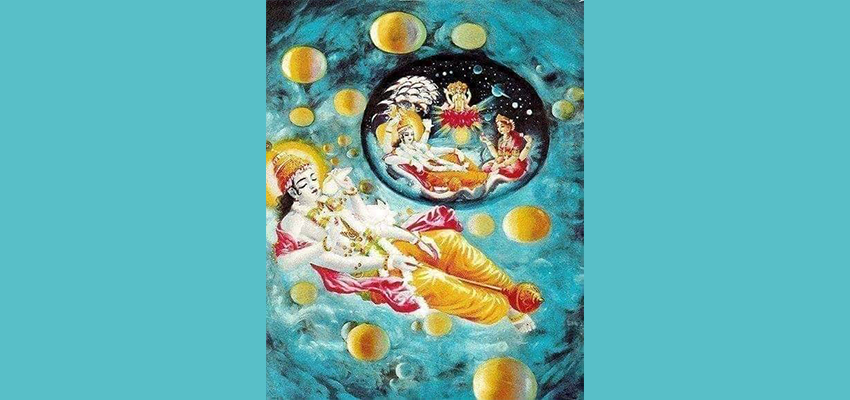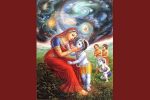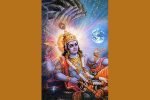NAME 8
Bhūtātmā भूतात्मा
He exists as Ātman in all the beings. Without Ātman or soul, no organism can exist. BṛhadāraṇyakaUpaniṣad (III.vii.20) explains this concept by saying, “eṣa ta ātmānantaryāmyamṛtaḥ एषतआत्मानन्तर्याम्यमृतः” This means that He is the immortal internal ruler, the Brahman. The qualities of the Brahman are being discussed through these nāma-s.
ŚvetāśvataraUpaniṣad (VI.xi) says, ‘sarvabhūtāntarātmā’, which means the inner most being. This nāma refers to this aspect of the Brahman.
८. ॐ भूतात्मने नमः
8. Om Bhūtātmāne Namah
(8) Bhootaatmaa -He is the Aatman (soul) of all the beings (“bhoota”): The very ‘Be’ in the living beings. Just as the same universal space manifests in all rooms as the room-space, so the Infinite Life manifesting through any given vehicle is called the Aatman of the vehicle. It is well known that space everywhere is one and the same; so too, the One Reality sports as though different Aatmans. This One Universal Soul is called in Vedanta the Supreme Brahman (Para-Brahman) .InBhaagavata, the Lord is addressed as “You are the One Self in all living creatures ever illumining all their experiences.’’ In Kathopanishad: “The One enchanting Truth that revels in every form manifesting in plurality”.
The AtmA or soul of all beings – sarveshambhutanamatma.
INTERPRETATION GUIDED BY SANT VANI (WORDS OF SAINTS)
Bhūtātmā, that is, The ātmā of all.
Bhūtānāmātmā, antaryāmī–He is in the form of all the bhūtas- beings. Bhuta also stands for the 5 elements – akasha/space, Aapah/water, Vayu/air, Agnih/fire, prithvi/earth.
Bhuta here is not a ghost as in Indian regional languages. He is the ātmā, the svarūpa of all the bhūtas.
He is the adhiṣṭhana of all the bhūtas, all the elements and elemental truth of the entire world. He is the indweller of all the beings.
He who lives within each being, as the Ātmā that अंतर्यामी (Antaryāmi), who dwells deep within the cave of the heart and is established there as the ‘living-principle’ and is an Aṁșā of the divine – the divine spark within.”
How should one understand this name and put it to practical use in our daily life? A brief explanation below:
This अंतर्यामी (Antaryāmi) can be meditated upon by establishing the “इष्ट देवता (iṣṭa-devatā)” within this heart-space and guidance and support will come. This is the real प्राण प्रतिष्ठा (Prāṅapratiṣṭha) – its true and deep meaning and allegorical significance when it is done as part of the पूजा-विधि (Puja-Vidhi) at homes and temples.
In the बृहदारण्यक उपनिषद् (Bṛhadāraṇyaka Upaniṣad), in that great debate in King Janaka’s court, the sage Yājñavalkya in responding to UddalakāĀruni’s question on the Antaryāmi Brahmaņ states that it is the Ātmā that resides within everything/every being – animate or inanimate – be it the Pancha Bhūtas or the three-worlds, or the heart-space within each being. Dwelling within, he is the साक्षी (Sākṣi) – the conscience-keeper.
Yājñavalkya further states: “He knows them, but they know not him; He alone is the ‘Knower’” – meaning, it is for the individual to unravel the mystery of the eternal secret that dwells within (in the cave of the heart) as that Guhyatamaṁ-Jnana (Secret Knowledge) – this is the whole purpose of Sadhana, meditation, puja or whatever one calls it.
“esa ta atmantaryamy amrtah:” The Ātmā is the अंतर्यामी (Antaryāmi) that is immortal”
In ‘Knowing” the ‘Knower‘, the ‘Knower‘ and “That which is Known” become one
In the Bhagawad Gita (Chapter-09; Verse-01; Raja-Vidya-Yoga), Krishna tells Arjuna that what he (Krishna) is about to impart is this Guhyatamaṁ-Jnana…
श्रीभगवानुवाच |
इदं तु ते गुह्यतमं प्रवक्ष्याम्यनसूयवे |
ज्ञानं विज्ञानसहितं यज्ज्ञात्वा मोक्ष्यसेऽशुभात् || 1||
śhrī bhagavān uvācha
idaṁ tu te guhyatamaṁ pravakṣhyāmyanasūyave
jñānaṁ vijñāna-sahitaṁ yaj jñātvā mokṣhyase ’śhubhāt
He who lives within each being, as the Ātmā that अंतर्यामी (Antaryāmi), who dwells deep within the cave of the heart and is established there as the ‘living-principle’ and is an Aṁșā of the divine – the divine spark within.”



